From The CRPG Addict
 |
| Kind-of a weird image choice for the box. Is that supposed to be one of the “maps”? |
Wizardry: Crusaders of the Dark Savant
Date Ended: 2 December 2018
Ranking at Time of Posting: (to come later)
I don’t apologize for a blog whose purpose is to chronicle these reactions, from the perspective of a modern player, but I do apologize if I don’t put sufficient context around my criticisms, or if I don’t balance them by highlighting the positive content and mechanics of the game. Looking over my previous entries on Crusaders, I don’t think I conveyed often enough that even though I had some issues with some of the storytelling and other content, those reactions were in the context of a title that kept me up all night playing. Even in the “game world and story” category, Crusaders is going to perform well.
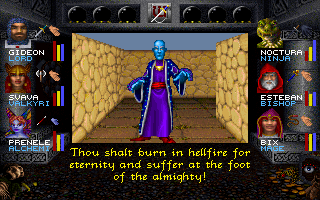 |
| One of the more broadly-drawn and poorly-explained factions in the game. |
 |
| Is it a time for a new purpose, or a new perception of purpose? |
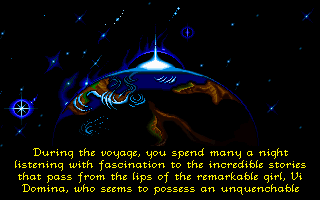 |
| This is laying it on a little thick. |
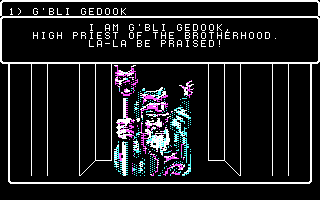 |
| And it begins. |
Having said all of that, it’s important to keep in mind that in my complaints, I’m evaluating Crusaders against a modern game, or an “ideal” game, rather than other 1992 games. Compared to its own contemporaries, there’s no question that Crusaders deserves a high score in the “game world” category. More important, it deserves high scores in the equipment, combat, and character development categories. The mechanics of the game are excellent. The worst thing Bradley could have done when taking over the series was to jettison the approach to combat introduced in the first Wizardry, but he did a good job keeping its fundamental tactics alive. He, or someone, deserves credit for perfectly balancing the “rest” system. If it had restored everything, as it does in Might and Magic, the game would have been far too easy and all the challenge would have come down to individual battles. If they’d made you return to a central location to restore spells and health, as in the first five games, extended expeditions would have been a nightmare. As they programmed it, resting restores just enough hit points and spell points to keep you going, but it takes just long enough, and offers just enough chance for random encounters, that you’re discouraged from abusing it.
I’m on the fence about certain aspects of the game world and quest. In general, I favor open game worlds with nonlinear narratives, and even games where the main quest itself is something of a mystery. Crusaders checks all those boxes. It also deserves credit for making its game world somewhat dynamic, with roaming NPCs who engage in (off-screen) conflicts with each other and sometimes (often, in my case) find key treasures before the party does.
 |
| The “Locate Person” spell helps keep tabs on constantly-shifting NPCs. |
On the other hand, I wouldn’t have minded if the game had offered a little more guidance on the main quest, particularly in respect to the 11 “maps” that become the focus of the exploration and quests. (I put that in quotes because they’re not really maps at all, but texts.) I was deep into the game before it became clear that assembling the set of maps was the primary goal of exploration. Just a few lines in the manual or in-game backstory would have cleared up a lot of confusion.
Hardcore Gaming 101 has an excellent paragraph that describes some of the negative aspects of the open game world:
The game is entirely non-linear, and upon landing the player doesn’t even get a clue what to do first. Even though most areas are effectively locked off due to being inhabited by far too strong monsters, the game is always dominated by a crushing feeling of being lost. The world is full of items that absolutely have to be kept, remembered, and recognized for puzzles somewhere at the other end of the world, dozens of gameplay hours later. Many puzzles aren’t necessarily all that hard on their own, it’s just that the ingredients are spread out too far, and the hints are often obscure, if there are any hints at all.
But it’s again important to remember that Crusaders was pioneering new territory here. Only a few games prior to it were as physically large, long, and complicated, and the developers didn’t have a lot of good examples to draw upon for balancing such a large world and complex plot. In the end, I’m grateful that Crusaders advanced the importance of detailed stories, NPC interaction, side-quests, sub-quests, and player choices. As such, I would be surprised if the GIMLET didn’t put the game in the top 5. Let’s see:
1. Game world and story. Crusaders offers a detailed backstory that plays a significant role in the game itself. There are multiple factions with their own characteristics and motivations, history, and lore. The characters’ actions visibly affect the world, and the game is one of a rare few in which some events happen dynamically, without the player’s input. There are aspects of each of these elements to criticize, but I’ve mostly done that enough. Score: 7.
2. Character creation and development. Mechanically, the game’s approach is about as good as any game on the market. It has a full set of race choices, class choices, attributes, and skills, several magic systems, and meaningful inventory restrictions by race and class. (I think some of the races are stupid, but that’s a minor concern.) Different selections create different experiences for different players. The ability to switch classes, while perhaps unbalancing the game a bit, adds additional dimensions to character development. Development is regular and rewarding throughout the game.
On the negative side, the classes and races really don’t play any meaningful role in the game, at least not in a way that was clear to me. Certain skills are useless or mostly useless, and I don’t think the game gained anything by dividing skills into multiple categories. Score: 7.
 |
| Defeating the Dark Savant kicked everyone up a level. |
3. NPC interaction. I actually think the series took a step backward here. In the system introduced in Wizardry V and included in VI, characters can have full-sentence dialogues with NPCs, but the previous games seemed to offer a more sophisticated interpreter in which full sentences were actually necessary. Phrasing things as statements or questions, even with the same keywords, might produce different results. Here, the game just seems to scan for keywords regardless of their positions in the sentence or the surrounding text, and I offered a few joking screenshots along those lines.
Having said that, I don’t really mind this “dumbing down” of dialogue, since it was always frustrating to figure out exactly how to phrase a question to get an intended result. What I do mind is that the NPCs respond to a lot fewer keywords than their Cosmic Forge counterparts while simultaneously tripling their dialogue quantity. They are also a lot goofier and thus less realistic.
Back on the positive side, I like the way NPCs roam around and engage in conflict with each other, and I wish the game had done more with this, offering more reasons to seek out, track down, and ally with (or oppose) various NPCs. Instead, since encountering NPCs is non-optional and results in pages of unskippable and unvarying dialogue, the game effectively encourages the player to simply kill everyone.
The end result of the goofy names and characterizations and long-winded introductory dialogue, there wasn’t a single NPC in the game that I actually liked. That’s particularly too bad given that, mechanically, the game supports fairly deep interactions with its NPCs. Score: 6.
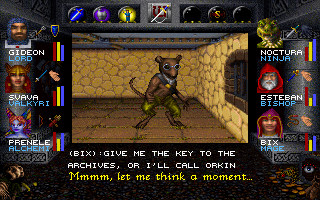 |
| One of the game’s goofy NPCs responds solely to the word “archives.” |
4. Encounters and foes. The foes are mostly originally-named, which in this case is a negative because most of the names are silly. I didn’t like that so many enemies used the same graphics and were thus difficult to distinguish, even though their strengths and weaknesses might vary considerably. On the other hand, the bestiary is satisfyingly large, with enough strengths and weaknesses among them to create different tactical challenges.
Non-combat encounters were plentiful and engaging, and while they didn’t offer a lot of opportunities for role-playing, many of them provided challenges of satisfying difficulty. Score: 6.
5. Magic and combat. The magic and combat system continue to be the primary strengths of the series, and as I said above, Bradley deserves a lot of credit for adapting rather than replacing the system introduced over a decade prior. The various spells and enemy characteristics come together to create a near-infinite number of tactical choices, but everything is exquisitely balanced.
I see that in my GIMLET for Bane of the Cosmic Forge, more than five years ago, while giving the combat system a high score, I said I was “past the whole ‘line up your attacks and execute them all at once’ system.” I understand what I meant, favoring more tactical combat screens like those used in the Gold Box games, and anticipating more real-time (but no less tactical) combat as in Might and Magic III. Still, it was a short-sighted statement. Crusaders proves there was still life in the old system. Score: 7.
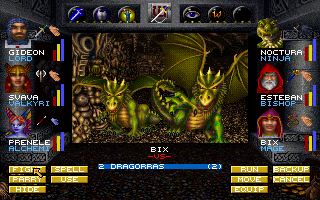 |
| I’m not sure I used “parry” once in the entire game. |
6. Equipment. My primary quibble here is that the game only gives you one “accessory” slot, and you find so many rings, necklaces, capes, belts, and similar items that it’s constantly torturous to choose among them. I also continue to dislike the identification system of the series. I don’t mind so much the process of casting “Identify” to view an items characteristics, but I rather wish that having done so, I could simply view the item in the future to remind myself of those characteristics, not have to cast the spell again. It makes evaluating multiple items a time-consuming, spell-point consuming chore.
But overall, the game does a good job here. There is a such a variety of weapons of different types and ranges, armor (helms, upper body, lower body, gloves, boots), and usable items that almost every treasure chest offers something useful. What I particularly like is that the selection of items in chests (and, to a lesser extent, on dead enemies) is mostly randomized. I hate when the same artifacts appear in the same locations for every player. Score: 6.
7. Economy. I didn’t talk about it much during my entries, but it’s not very good. The primary problem is that “stores” are mixed up with NPCs, and there simply aren’t enough of them selling enough useful stuff. You mostly end up selling rather than buying, amassing a huge amount of gold before the end, and spending most of it on plot-specific purchases (like ascending in the Dane Tower or buying your way into the Umpani legions) rather than equipment. I would have appreciated more places to spend gold and a less-cumbersome purchasing system. Score: 3.
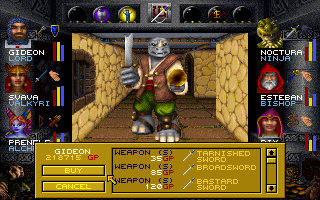 |
| I ended the game with far too much money and not nearly enough things to spend it on. |
8. Quests. With a main quest with not only multiple endings but multiple beginnings, faction options, and numerous side-quests and sub-quests (although it’s not always clear which is which), it’s hard to ask for more in this category except for better writing and greater complexity, both of which later games would offer thanks to titles like Crusaders setting the standard. Score: 8.
9. Graphics, Sound, and Interface. Perhaps the weakest category in my opinion. The graphics are certainly improved from previous titles in the series, but they’re still just textures. While many of the monster animations are fine, I wasn’t in love with anything else. Sound effects were at best adequate, at worst annoying (e.g., the continual background droning), and since they slowed down the game so much, I turned them off halfway through.
It’s tough to write a good interface in a game of this complexity, and while I eventually got used to it, there were aspects that bothered me until the end, including poor use of the keyboard, inability to switch between characters while in sub-menus, limited scope of the automap, lack of any way to determine coordinates, inability to skip text you’d already seen a million times, and a lot of unintuitive commands. Score: 3.
10. Gameplay. We get to end the GIMLET on a positive. Crusaders is the first truly non-linear Wizardry, and it’s about as nonlinear as you can get (even the starting and ending locations can vary) except that the so-called “outdoor” world is still pretty confining and there’s a bit of frustration involved in simply getting from once place to another. The faction options, ending options, and different experiences afforded to different character classes make it highly replayable. Its difficulty is pitched perfectly, and even adjustable.
Although it avoided the worst flaws of long games, such as artificial level caps and a general feeling that characters stopped developing, 100+ hours is still far too long. I don’t mind games with optional content that push past the 100-hour mark, but otherwise I feel that a game is becoming indecent if it exceeds a couple of work weeks. Score: 7.
That gives us a final score of 60, tying it for the sixth-highest rating on my blog so far, seven points higher than Wizardry VI. As much fun as I’ve made of David Bradley, the inescapable result of his involvement with the series is that it kept improving–in sharp contrast to a lot of series of the era that, while advancing in superficial elements like graphics and sound, struggled to out-perform their first installments in core RPG mechanics.
| “True point & click mouse interface.” Ugh. Eventually games will come full circle and say things like, “Makes effective use of the full keyboard.” |
 |
| “One day” being nine years from now. |
[C]ontemporaneous memoranda do not indicate that Bradley was ever unable to work and, in fact, make absolutely no reference to the Federal court action. In sharp contrast to the position taken in Sir-Tech’s complaint, these writings provide persuasive evidence that the sheer magnitude of the Crusaders project, programming and operating system problems and, quite possibly, Sir-Tech’s own impatience and interference, were the major causes for the delay, which extended for a full year beyond the September 1, 1991 deadline and, in fact, approximately six months beyond the dismissal of the Federal court action.
In 1994, sensing the project had become a money pit, Sir-Tech canceled further work on what would have been Wizardry: Stones of Arnhem. This might have been a wise move for thematic reasons, too: nothing about the game, as far as I can tell from the documentation, suggests it would have been a sequel to Crusaders. In the Barton interview, Sirotek even suggests it may not have gotten the Wizardry label.
 |
| A map from the development of Stones of Arnhem. Oddly, most of the major locations named on the map are real place names in Australia. |
Crusaders of the Dark Savant is the third-longest game on my blog, in raw hours. I’ve had it going on and off since August. In some ways, I’m sorry it’s over because it means I have to focus on a series of RPGs that are a lot less approachable. Let’s see if I can get anywhere with any of them.
Original URL: http://crpgaddict.blogspot.com/2018/12/crusaders-of-dark-savant-summary-and.html
